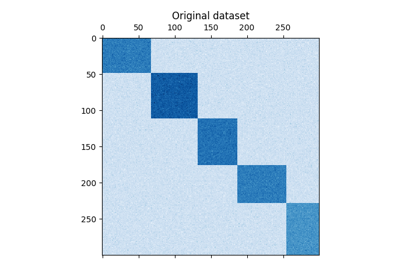make_biclusters#
- sklearn.datasets.make_biclusters(shape, n_clusters, *, noise=0.0, minval=10, maxval=100, shuffle=True, random_state=None)#
生成一个用于双聚类的常量块对角结构数组。
更多信息请参阅 用户指南 。
- Parameters:
- shape形状为 (n_rows, n_cols) 的元组
结果的形状。
- n_clustersint
双聚类的数量。
- noisefloat, 默认=0.0
高斯噪声的标准差。
- minvalfloat, 默认=10
双聚类的最小值。
- maxvalfloat, 默认=100
双聚类的最大值。
- shufflebool, 默认=True
打乱样本。
- random_stateint, RandomState 实例或 None, 默认=None
确定数据集创建的随机数生成。传递一个 int 以在多次函数调用中获得可重复的输出。 请参阅 术语表 。
- Returns:
- X形状为
shape的 ndarray 生成的数组。
- rows形状为 (n_clusters, X.shape[0]) 的 ndarray
每个行所属聚类的指示器。
- cols形状为 (n_clusters, X.shape[1]) 的 ndarray
每个列所属聚类的指示器。
- X形状为
See also
make_checkerboard生成一个具有块棋盘结构的双聚类数组。
References
[1]Dhillon, I. S. (2001, August). Co-clustering documents and words using bipartite spectral graph partitioning. In Proceedings of the seventh ACM SIGKDD international conference on Knowledge discovery and data mining (pp. 269-274). ACM.
Examples
>>> from sklearn.datasets import make_biclusters >>> data, rows, cols = make_biclusters( ... shape=(10, 20), n_clusters=2, random_state=42 ... ) >>> data.shape (10, 20) >>> rows.shape (2, 10) >>> cols.shape (2, 20)


